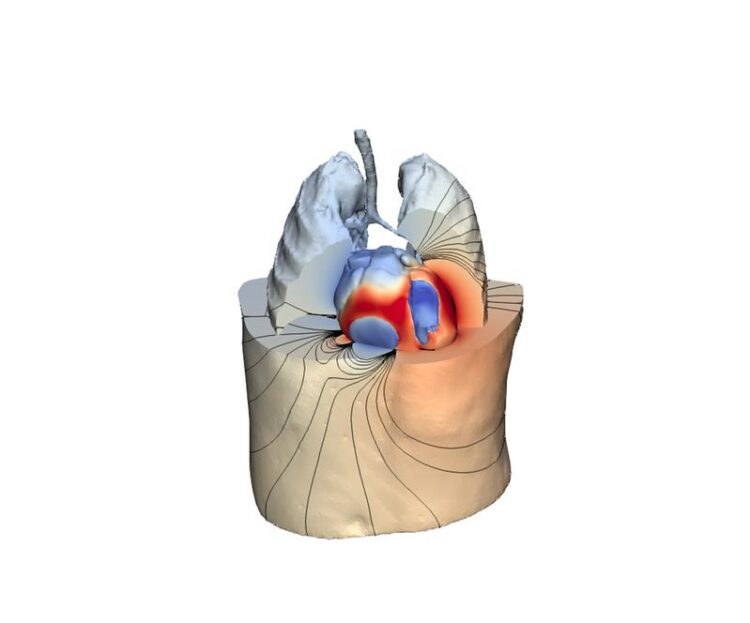Cardiovascular diseases: New computer model improves therapy

Illustration of a digital twin from a human heart.
© Plank – Med Uni Graz
Using mathematical image processing, scientists at the BioTechMed-Graz research cooperation have found a way to create digital twins from human hearts. The method opens up completely new possibilities in clinical diagnostics.
Although treatment options are constantly improving, cardiovascular diseases are still one of the most frequent causes of death in Europe. The success of the treatment varies from patient to patient and depends on the individual clinical picture, as Gernot Plank, researcher at the Institute of Biophysics at the Medical University of Graz explains using an example: “For example, pacemaker therapy is not successful in about 30 per cent of cardiac patients who have had a pacemaker implanted for mechanical resynchronization of the heartbeat.”
In order to be able to rule out such interventions in advance, Plank has developed a computer model together with the mathematicians Gundolf Haase and Kristian Bredies from the University of Graz and computer scientist Thomas Pock from the Institute of Computer Vision and Representation at Graz University of Technology, respectively, with which doctors can pre-simulate the optimal therapy and dramatically improve the success of treatment.
Digital one-to-one models
The researchers use diagnostic data from MRI, ECG and other heart examinations of the person to be treated. Imaging algorithms put together a digital image of the patient’s heart from this data material. This customized model ultimately provides a wealth of information that helps to understand the individual clinical picture and to run through various therapeutic scenarios.
Thomas Pock explains the challenge behind it: “To simulate such a heartbeat in the computer, you have to calculate millions of variables. This requires complex mathematical procedures, special algorithms and special hardware that can perform billions of computing actions per second.”
Method is ready for use
The developed method is so sophisticated and automated that anatomically correct digital twins of patient hearts can already be routinely produced in a clinical setting. In a next step, the researchers want to further improve the technology and enable fully automatic adjustment of all functional aspects of the heartbeat. “This requires further efforts in basic research, especially in those areas of machine learning and artificial intelligence (AI) that allow a high degree of personalization,” explains Pock.
Focus on further development
A very promising approach is based on the latest AI methods for optimal control and focuses on the wave propagation in the heart, which is controlled by the alignment of the heart muscle fibres. The consortium wants to implement this approach in cooperation with Cardiocentro Ticinio (centre for computer-assisted cardiology, Lugano) in a new research project and try to incorporate the “control elements” into the model using machine learning techniques in such a way that the simulated heartbeat comes as close as possible to the real heartbeat.
The first clinical validation studies are in preparation for 2021 in cooperation with Daniel Scherr from the Division of Cardiology at the Medical University of Graz. Plank and Pock assume that clinically usable prototypes of a fully automated digital twin heart can be tested as early as 2022. The simulation technology on which the method is based is already being distributed by the Graz-based start-up NumeriCor and is used by leading medical technology companies in the R&D sector.
The participating researchers are part of the inter-university research network BioTechMed-Graz. This is a shared initiative of the Medical University of Graz, Graz University of Technology and the University of Graz in the field of biomedical sciences.
This research topic is anchored in the Field of Expertise “Information, Communication & Computing”, one of the five strategic research foci at TU Graz.
Wissenschaftliche Ansprechpartner:
Gernot PLANK
Univ.-Prof. Priv.-Doz. Dipl.-Ing. Dr.techn.
Medical University of Graz | Institute of Biophysics
Phone +43 316 385 71526
gernot.plank@medunigraz.at
Thomas POCK
Univ.-Prof. Dipl.-Ing. Dr.techn.
TU Graz | Institute of Computer Graphics and Vision
Phone: +43 316 873 5056
pock@icg.tugraz.at
Weitere Informationen:
https://www.numericor.at/ (Start-up Numericor)
https://biotechmedgraz.at/en/ (BioTechMed-Graz)
https://www.tugraz.at/institutes/icg/home/ (TU Graz | Institute of Computer Graphics and Vision)
https://biophysik.medunigraz.at/en/ (Medical University of Graz | Institute of Biophysics)
Media Contact
All latest news from the category: Medical Engineering
The development of medical equipment, products and technical procedures is characterized by high research and development costs in a variety of fields related to the study of human medicine.
innovations-report provides informative and stimulating reports and articles on topics ranging from imaging processes, cell and tissue techniques, optical techniques, implants, orthopedic aids, clinical and medical office equipment, dialysis systems and x-ray/radiation monitoring devices to endoscopy, ultrasound, surgical techniques, and dental materials.
Newest articles

Scientists transform blood into regenerative materials
… paving the way for personalized, blood-based, 3D-printed implants. Scientists have created a new ‘biocooperative’ material based on blood, which has shown to successfully repair bones, paving the way for…

A new experimental infection model in flies
…offers a fast and cost-effective way to test drugs. Researchers at the Germans Trias i Pujol Research Institute and Hospital have reinforced their leading role in infectious disease research by…

Material developed with novel stretching properties
KIT researchers produce metamaterial with different extension and compression properties than conventional materials. With this material, the working group headed by Professor Martin Wegener at KIT’s Institute of Applied Physics…



